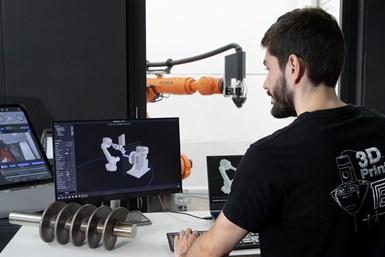Robot Slicer Software Simplifies Wire-Laser Metal 3D Printing Technology
The Meltio Space toolpath generator employs a virtual model of real robot movement, empowering users to create intricate, customized and highly detailed 3D-printed metal parts.
Meltio created the Meltio Space toolpath generator to facilitate the use of its metal 3D printing solutions. By offering a user-friendly interface and comprehensive features, this robot slicer simplifies the integration of Meltio’s wire-laser metal 3D printing technology — which can be used for the manufacture or maintenance of medium parts and molds — by offering a built-in robot library and postprocessors for some of the most popular robotic brands, including ABB, KUKA, FANUC and Yaskawa.
This toolpath generator software for the Meltio Engine Robot Integration offers an easy-to-use interface for planar, nonplanar and variable extrusion toolpaths. It also includes two-axis workpiece positioner interpolation, kinematics simulation, collisions check and cell configuration.
Featuring an intuitive design, users can quickly adapt to and leverage the benefits of robotic additive manufacturing (AM) without requiring expertise in robotics or programming. Also, Meltio Space goes beyond the constraints of traditional three-axis systems. With its integration of a six-axis robotic manipulator and two-axis workpiece positioners, it opens up a new realm of possibilities for metal 3D printing.
Meltio Space includes preset and recommended material profiles and 3D printing parameters. Moreover, Meltio Space removes complexity in the 3D printing workflow, making it accessible to industrial users of all levels.
With a strong focus on user experience, it offers a fully tailored customer journey centered around the seamless integration between the Meltio Engine and Meltio Space. The software offers custom-developed Meltio print profiles for the Meltio materials portfolio.
Meltio Space robot slicer employs a virtual model of the real robot movement. This advanced feature enables users to simulate the kinematics of the robot, ensuring accurate and precise printing. Additionally, the slicer performs collision checks with the part being printed, minimizing the risk of errors or damage during the additive manufacturing process.
Related Content
-
3D Printing Technologies for Moldmaking Applications
3D printing technologies, from conformal cooling to complex mold building, are making an impact on the moldmaking industry, one innovation at a time.
-
MMT Chats: The Connection Between Additive Manufacturing Education and ROI
This MMT Chat continues the conversation with Action Mold and Machining, as two members of the Additive Manufacturing team dig a little deeper into AM education, AM’s return on investment and the facility and equipment requirements to implement AM properly.
-
Large Hybrid Steel Insert Solves Deformation, Dimensionality, Cycle Time Problems
DMLS printers using metal additive powders selected by Linear AMS to produce high-quality, accurate, consistent 3D-printed mold components with certification and traceability.













.jpg;maxWidth=300;quality=90)


